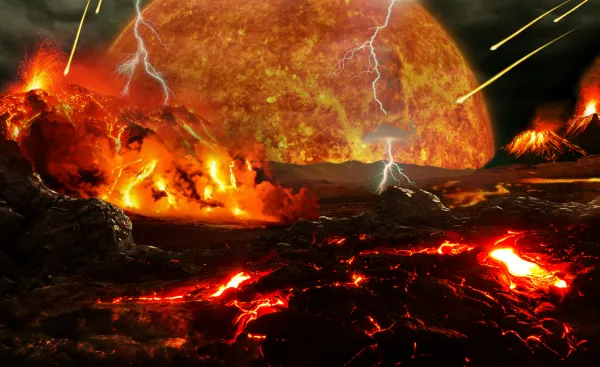Exploring the Potential of Blockchain Technology in Unveiling the Origins of Life
“Maybe society could be happier about using cryptocurrencies if you could tell people that, in the process, we could discover new laws of biology or some new cancer drug.”
The utilization of blockchain technology by a team of chemists has resulted in the creation of a vast computer network capable of exploring the origins of life on Earth. This innovative application of blockchain demonstrates its potential to address challenges beyond the realm of finance. Additionally, the study conducted by the team may have provided valuable insights for scientists in their quest to understand our beginnings.
Through their mechanism, the researchers discovered that certain rudimentary forms of metabolism, which involve chemical reactions converting food into energy within living cells, could have emerged without the involvement of enzymes or proteins that facilitate these reactions.
Now, you may wonder why the team specifically chose to employ blockchain technology for their investigation. The answer lies in the complexity of studying pre-life or “prebiotic” chemistry, which entails examining over 11 billion potential reactions between molecules. The sheer number of permutations involved makes it an immensely challenging task. To tackle this obstacle, the team, led by Bartosz Grzybowsk of the Korea Institute for Basic Science and the Polish Academy of Sciences, lacked access to a supercomputer capable of handling such a massive investigation. Consequently, they turned to a platform called “Golem.”
Golem functions as a cryptocurrency-mining platform that coordinates numerous calculations across hundreds of computers worldwide, compensating participants with cryptocurrency in exchange for their computing power.
Grzybowski, in an interview with Space.com, highlighted the benefits of utilizing this cryptocurrency to obtain computing power. He clarified that his team, despite their involvement, does not have any investments in Golem. The team sought to enhance their computing capabilities and found success through a global computing system, where thousands of individuals collaborated and granted them access to approximately 20,000 CPUs worldwide.
Initially, the team established the Network of Early Life (NOEL), consisting of molecules that likely existed on Earth billions of years ago, such as water, methane, and ammonia. They then narrowed down the extensive list of 11 billion potential prebiotic reactions to a more manageable 4.9 billion reactions.
Grzybowski emphasized that even with this reduction, NOEL remained a network that was approximately 100,000 times larger than the one used in their previous research on the origins of life, which was published in 2020.

Within NOEL, various reactions are possible, including those that form part of metabolic pathways. For example, glycolysis is a metabolic pathway that involves the breakdown of glucose to produce energy. Additionally, NOEL includes reactions that closely resemble the Krebs cycle, which living organisms utilize to generate energy. Furthermore, NOEL encompasses reactions capable of synthesizing biotic molecules like sugars and amino acids.
NOEL revealed an astonishing finding to the team: out of the countless reactions they conducted, only a few hundred resulted in the creation of self-replicating molecules. This rarity took them by surprise, as they discovered that only one reaction or cycle out of every million had the ability to self-replicate. This discovery holds great significance, as self-replication, also known as “auto amplification,” has long been regarded as a crucial factor in the emergence of life.
Chemists have debated for decades about the possibility of molecules in the early stages of chemical evolution forming cycles that would produce additional copies of the same material. Some argue that certain molecules replicated faster than others, leading to potential pathways for evolution to follow. On the other hand, some origin-of-life chemists believe that the simplicity of early pre-biotic molecules prevented them from replicating as complex biological molecules like DNA do. Grzybowski believes that this investigation could settle the debate, as it surprisingly suggests that self-replication did not occur prior to the evolution of larger molecules.
Despite not observing self-replication in the origins of life, Grzybowski remains hopeful about the concept. He acknowledges that self-replication must have emerged at some point, considering that biology now demonstrates this ability. The question that remains is at what stage of complexity did molecules begin to replicate themselves?
Regarding the utilization of Golem for the creation of extensive and robust computer networks, Grzybowski suggests that this technology could be widely adopted by researchers who lack access to supercomputers but require significant computational capabilities. He emphasizes that there are numerous scientists who do not have the privilege of owning their own supercomputers, and they can leverage platforms like Golem, which are distributed globally, to access these resources. Grzybowski further suggests that if the potential of Golem and cryptocurrencies in general is communicated in terms of the possibility of discovering new biological laws or developing novel cancer drugs, it could potentially increase societal acceptance and enthusiasm towards their usage. The team’s research findings were published in the journal Chem on January 24th.
This article is republished from space.com under a Creative Commons license. Read the original article.
Do not forget to share your opinion with us to provide you with the best posts !



0 Comments